Semi-dry floor screed - finishing work No. 1 in the list of any builders. That's how it is in construction, that rough work is carried out first, and then all cosmetic repairs.
A solid and even floor is the basis of any room. In the matter of floor screed, it is extremely important to do everything right - after all, this is the basis. It is important to accurately calculate the proportion of the mixture, check everything and make the floor perfectly flat. There are various technologies for preparing the mixture, it is important to have a set of necessary tools, and also have experience in the issue of semi-dry cement floor screed.
Before starting work, it is necessary to determine the thickness of the cement screed. Usually, it is selected within 40-80 mm. Incorrect choice of thickness can lead to cracks or delamination of the layer from the base. Also of great importance is the type of screed., which will be formed on your floor. It can be either cement, or concrete screed.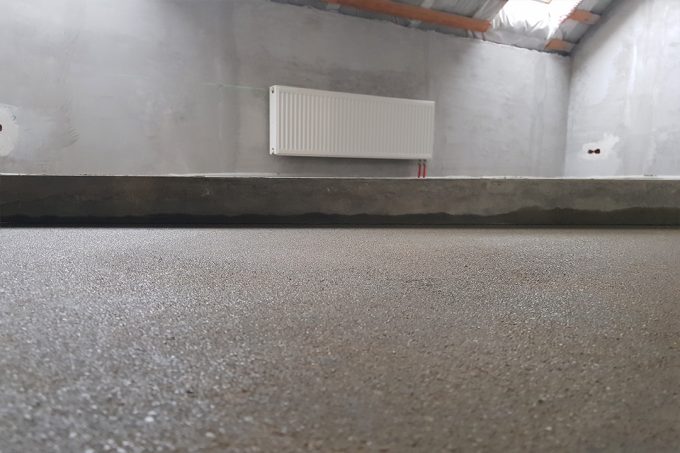
Cement-sand semi-dry screed has a number of advantages:
- advantages low cost of materials used;
- ease of mixing;
- obtaining a smooth surface with little effort;
- high rate of providence work.
The construction company "Aplaster" presents you a full range of works on laying cement semi-dry floor screed, qualified specialists perform their work quickly and efficiently, details on the cost of work on the site https://aplaster.ru/styazhka-pola-v-kvartire/
Filling the floor with concrete or semi-dry screed
Of course, concrete floors have a high degree of strength and durability., due to which they are indispensable in industrial premises with heavy loads. Also used in private housing construction, tk. concrete screed levels the surface of the floor and serves as an ideal base for flooring. Compliance with the rules of the technological process of pouring concrete guarantees a long service life of the floor. But, must be considered, that in the apartment to carry out concreting in the classical way, it is difficult and costly. The cost of a dry screed is almost 2 times the cost of semi-dry. The classic "wet" screed will cost 10-15 % more expensive plus additional costs, associated with either self-leveling floor, or overspending tile adhesive.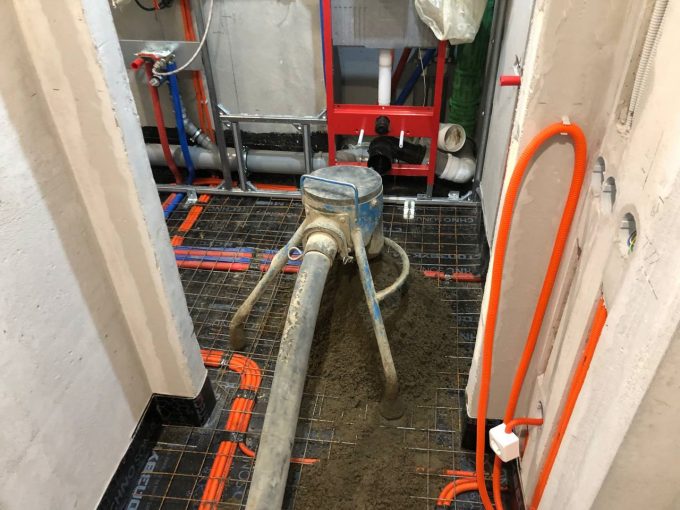
A very important advantage of the semi-dry method is the absence of drops and cracks.. The use of a minimum amount of water prevents uneven drying of the screed, and thanks to the trowel, which grinds the screed, the surface is additionally compacted and it turns out perfectly flat.
In accordance with SNiP, the possible allowable differences are by 2 m 2 millimeter. The use of this technology eliminates additional costs, associated with the use of self-leveling floor.
Due to the minimum amount of water in the semi-dry screed, cement-sand mortar is not liquid, easy to pull out, which significantly increases the speed of work.
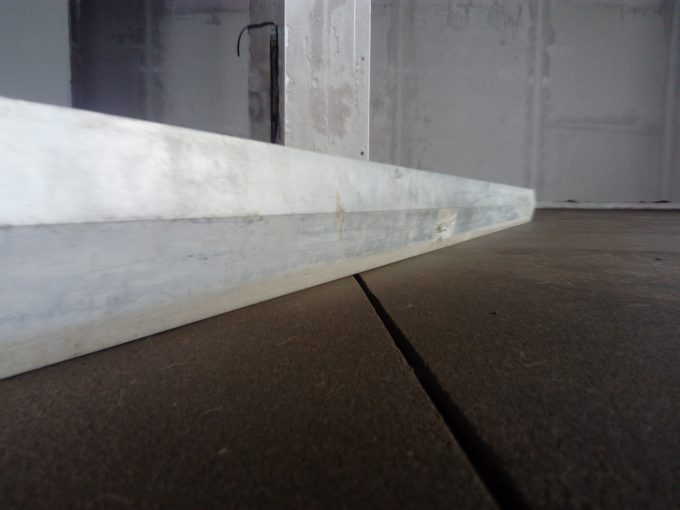
For example, when installing a screed in the classical way, one team is able to fill in a shift 100 square meters, whereas in a mechanized way, the same team is able to fill 250-300 square meters of screed. You can watch a video at the end of the article, which reflects the advantages of the speed of work.
Procedure for classical concreting
Foundation preparation is an important step.. The procedure for preparing the base depends on its type.. If the concrete is to be laid on the ground, then you should get rid of the vegetation, roots and cobblestones. The soil is then compacted. A layer of sand or gravel is poured, whose thickness is 10 cm. As for the old concrete base: defects are eliminated (cracks, potholes), cleaned and grouted.
In case of unsuitability for operation, the old concrete is dismantled (partially or fully).
Next up is waterproofing., and beacons are set. Lighthouses are not to be ignored., because it is thanks to them that the general level of pouring concrete is determined and the evenness of the future floor is ensured.
Preparation and pouring of the solution.
Concrete mortar is produced by mixing dry ingredients manually or using a concrete mixer.. The use of technology allows not only to prepare a better solution, but it also saves time and effort.. Concrete pouring is carried out with or without formwork. If you need extra strength, concrete floor reinforced with reinforcing cage, steel fiber or mesh.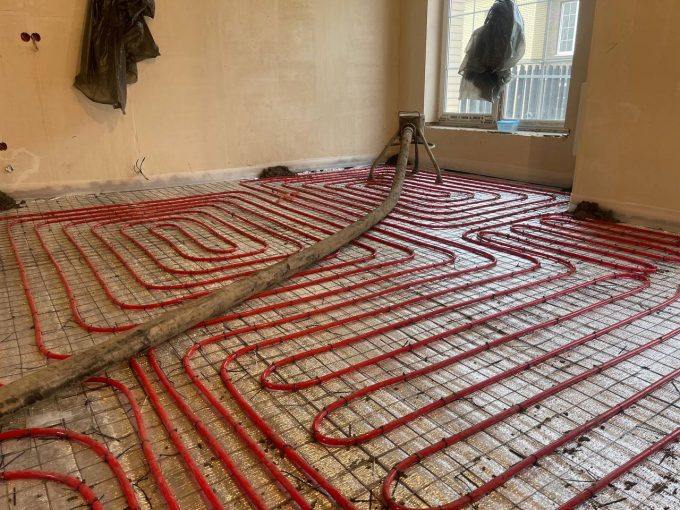
The filling of the solution is carried out gradually. Concrete is evenly distributed and compacted to remove air voids using an internal vibrator. Before, how the concrete mortar began to harden, its surface is smoothed.
Surface finishing is done after, how concrete begins to harden, through 2-3 hours, depending on conditions. For this, a grater or trowel is used.. After grouting, the floor surface becomes smooth and even.. Before laying the coating, the floor should be dedusted and treated with a special solution..
The technology for pouring a concrete floor is always the same, however, there are no generally accepted building solutions. Depending on the design of, location and purpose concrete floor is calculated individually for each customer. The process of pouring concrete floors takes quite a lot of time and effort., but, despite this, the concrete floor is the most reliable,but the use is not always justified, especially in apartments .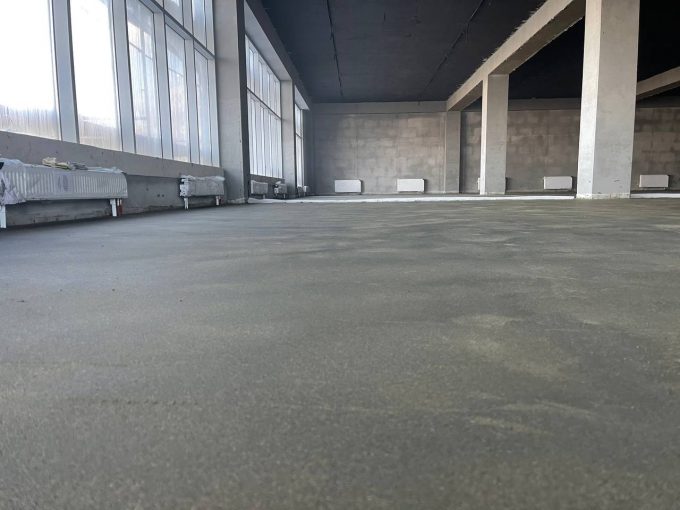
The main advantage of a semi-dry screed is the speed and quality of work performed.. With special equipment (grouting) ready-made cement-sand mortar, composed of sand, cement, fiber and water, delivered from the street through special hoses directly to the object. This solution can be applied up to 30 floors (100 meters vertically) and to 200 meters horizontally. In this way, there is a significant time saving when manually lifting materials for a classic screed to the object.












